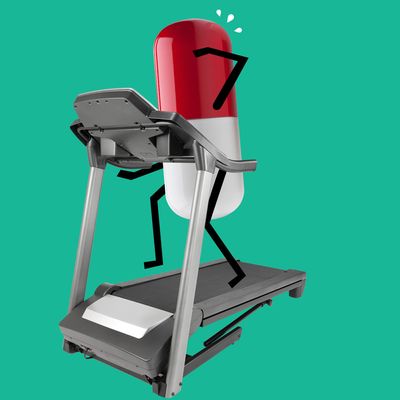
The latest issue of the journal Nature holds a glittering vision of a possible future: Scientists at the Harvard Stem Cell Institute have managed to trick white fat cells into behaving as if they were brown fat cells. For those who have not been closely following the last decade of obesity research: White fat cells are the ones that store excess energy (a function that can result in obesity), while brown fat cells, on the other hand, burn excess energy (which means weight loss).
“What our study shows is that it’s possible to find a drug that would make your bad fat cells get up off the couch and do something good for you,” Chad Cowan, one of the paper’s co-authors, told Science of Us.
So yes, it’s an exciting step forward. But is this really a “pill to replace the treadmill,” as some media reports have characterized it? Well, yes and no, said Cowan. “I think that people like the fact that pill and treadmill rhyme,” he explained. “So that kind of caught on.” There’s at least a little truth to these attention-grabbing headlines, though: When it comes to burning fat, this technique Cowan and colleagues developed actually does do what exercise does, to an extent. “What we know is that when animals and humans exercise, you get fat that becomes more metabolically active” — your fat cells begin to burn off excess calories instead of storing them, Cowan said. “So it is sort of replacing the effect of exercise on fat.”
On the other hand, though, it’s unlikely that any anti-obesity drug developed down the line from Cowan’s research will truly replace exercise, full-stop, simply because exercise carries with it so many mental and physical benefits in addition to weight loss — better sleep, sharper memory, and reduced stress and depression, to name only a few. At least for now, you still need the treadmill for all that.
So how did Cowan and his team pull off this bit of trickery? They tested a small library of 1,000 molecular compounds, in a collaborative research project with Roche Pharmaceuticals; eventually, Cowan and colleagues found two that, once applied to the white fat cells, “taught” them to become metabolically active, as if they were brown. These cells “had all of the gene signatures of white fat,” said Cowan, but they “could just do something [they] couldn’t before.”
Cowan likes to use a familiar comic-book analogy to explain his research to laypeople. “It’s like Peter Parker — it isn’t like he isn’t still Peter Parker when he becomes Spider-Man. It’s just that now he can also do all these new and different things.” It isn’t entirely clear what would happen if people were to take a pill containing one of these compounds, but what Cowan and his colleagues expect is that this could lead to weight loss — without the bother of exercise. Again, there would still be plenty of reasons to remain physically active, but this could be an especially big deal for people with injuries or illnesses that cause limited mobility.
Research in this area had previously established that white cells could be manipulated into acting brown-like, but the effects were short-term; remove the compound, and the fat-burning vanishes, too. “But the other thing here [with our findings] is that this was a stable conversion: Once these cells were treated, they were always more metabolically active,” Cowan said.
Thinking (very) ahead, this could mean that people taking a medication based on these findings wouldn’t have to take the drug perpetually. “Your fat tissue is constantly replenishing itself … over the course of your lifetime, you’re getting all new cells and adipose tissue,” Cowan explained. “So you take the drug until you have enough metabolic cells so you can now burn X amount of calories in your sleep. But then you stop for a while, until maybe a year later, when your tissues have flipped over” — that is, until your body has produced fresh, untreated white fat cells that are again storing energy they could be burning.
The catch, so far, is this: Both of the molecules the researchers identified are immunosuppressive, meaning they limit the body’s ability to fight off illness. Increased weight loss for a weakened immune system is not a tradeoff Cowan and his colleagues are interested in making. “So as a next step — now that we know that this is possible — I’d really like to identify new pathways, new molecules that can do this,” he said. “It’d be great to have more shots on goal on this, and then narrow it down from there.”
It’s undeniably exciting to think about where this work will lead, but Cowan cautions that we are likely still at least ten years away from his team’s research yielding a commercially viable product. “Science, unfortunately, is full of these long-term investments and ideas,” he said. So just hang on for one more decade, everyone: The future of fat-burning is coming. Probably.




